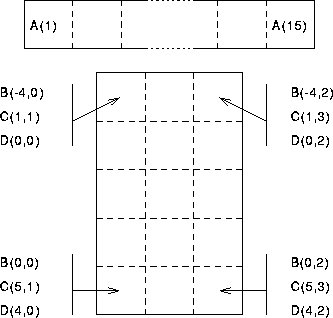So long as the value of lda is known![]() ,
the following are valid:
,
the following are valid:
REAL, DIMENSION(100) :: R
REAL, DIMENSION(1:10,1:10) :: S
REAL :: T(10,10)
REAL, DIMENSION(-10:-1) :: X
INTEGER, PARAMETER :: lda = 5
REAL, DIMENSION(0:lda-1) :: Y
REAL, DIMENSION(1+lda*lda,10) :: Z
The above example demonstrates:
INTEGER, PARAMETER :: lda = 0
then the array Y would be zero sized.
Zero-sized arrays are useful when programming degenerate cases especially when invoking procedures (in this case we would expect lda to be a dummy argument which determines the size of some local (or automatic) array); no extra code has to be added to test for zero extents in any of the dimensions -- statements including references to zero sized arrays are simply ignored.
Return to corresponding overview page ![]()
Consider the following declarations,
REAL, DIMENSION(15) :: A
REAL, DIMENSION(-4:0,0:2) :: B
REAL, DIMENSION(5,3) :: C
REAL, DIMENSION(0:4,0:2) :: D
Individual array elements are denoted by subscripting the array
name by an INTEGER, for example, A(7) ![]() element of A, or
C(3,2), 3 elements down, 2 across.
element of A, or
C(3,2), 3 elements down, 2 across.
The arrays can be visualised as below:

Figure 8: Visualisation of Arrays
The first dimension runs up and down the page and the second dimensions runs across the page.
Return to corresponding overview page ![]()